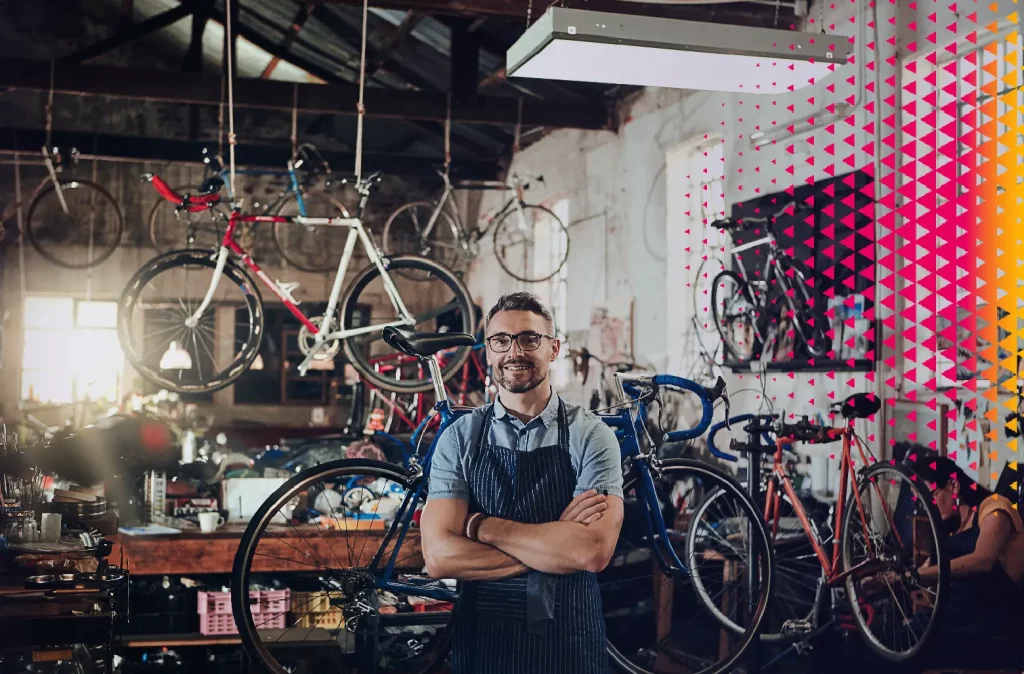Opening a Bike Shop: An Entrepreneur’s Guid

The bike market has experienced significant growth in recent years, with bike sales in France rising by 4% to reach 2.8 million units sold in 2021. Over the past two years, the market’s revenue has increased by an impressive 43%, driven primarily by the popularity of electric bikes (e-bikes). E-bikes now account for nearly one in four bikes sold in France and represent 59% of the market value. In short, it’s an ideal time to open a bike shop. But where should you start? What are the key steps? What should be your main priorities?
From market research and location to competition, strategy, and legal structure, this comprehensive seven-step guide will help ensure your project’s success and provide an exceptional customer experience.
Conduct Market Research on bike Shops
Even if you have some personal or professional knowledge of the bike market, it’s crucial to ask specific questions about the consumption and usage habits of your target audience. A thorough understanding of your customers is the first and most essential step in opening your bike shop and ensuring its success. This involves asking the right questions:
- What are the key trends in the bike market? (products, regulations, government incentives…)
- Who are the typical customers of bike shops? (demographics, profession, age, gender, socio-economic status, average budget…)
- When do people buy bikes? (professional or personal purchase, for themselves or for a family member)
- What are the buying behaviors of customers? (frequency of store visits, seeking information from a seller or online…)
- What products and services are most in demand in your target market? (buying or selling bikes, bike rental, repair and maintenance, accessories…)
After conducting macro market research, it’s important to carry out a competitive analysis (benchmarking) in your chosen location. You will need to:
- Identify existing shops;
- Study their teams and locations (number of staff in the sales area, shelving, square meters used…);
- Compare their product/service offerings and prices;
- Analyze their strategy (customer segmentation, communication);
- Assess their success or failure!
Choose a Suitable and Distinctive Concept
Once you have a deep understanding of your market, choose a concept for your bike shop that defines your business’s positioning among competitors. The location of your shop should directly influence your decision:
- If you’re by the sea, your clientele might be interested in bike rentals tailored to the environment;
- In urban areas, consider e-bikes and mobility products favored by commuters;
- In mountainous regions, sporty mountain bikes will attract an ideal clientele.
Our product and service offerings should align with the insights gained from your market research and the needs of your potential customers. To stand out from competitors, go beyond simply targeting your audience. Offer additional expertise on your products, provide advantageous repair and maintenance services, and allow customers to test-ride bikes before purchase. These strategies and more will help differentiate your shop in the market.
Franchise or Independent?
Joining a franchise network can sometimes deter entrepreneurs due to the limitations on strategic choices. However, franchising provides a substantial advantage by leveraging the brand’s reputation, allowing you to establish your business more effectively. It lets you rely on a proven concept and benefit from essential logistical and marketing support right from the start. Additionally, you gain access to a supplier database with pre-negotiated conditions, simplifying the supply chain process.
Remaining independent, on the other hand, liberates you from the rules and conditions imposed by a franchise network and the associated significant affiliation costs. While franchising can accelerate your initial growth and reduce the risk of failure, it may constrain long-term development and impose limitations on your business.
With your target audience analyzed and your concept in hand, selecting the right location for your shop is a strategic step for ensuring customer satisfaction. The goal is to secure significant and relevant foot traffic in your bike shop. If customers don’t show up, it’s tough to grow your business.
Find Your Location
With your target audience analyzed and your concept in hand, selecting the right location for your shop is a strategic step for ensuring customer satisfaction. The goal is to secure significant and relevant foot traffic in your bike shop. If customers don’t show up, it’s tough to grow your business.
Here are some tips:
- If you focus on urban mobility, especially for commuters, with electric bikes, reinforced mudguards, locks, or integrated security systems, choose locations in business districts or activity parks;
- If you favor made-in-France bikes, stylish bikes, and innovative products, target upscale neighborhoods with clients who have larger budgets and different priorities;
- If you’re focusing on rental services, opt for tourist areas and neighborhoods, which are vital for this type of clientele;
- Generally, aim for commercial streets, dynamic neighborhoods, and shopping centers to benefit from high foot traffic without being adjacent to another bike shop.
Choose a Legal Structure
The fifth step in your entrepreneurial journey is to legally establish your bike shop and set up its administrative framework. The legal status of your business significantly impacts your tax obligations, social protection, governance structure, share capital, and liability.
Here are your options:
- Micro-Enterprise: Easy and quick to set up, this is a specific form of individual business. Despite its simplicity and minimal startup costs, it has a significant drawback: a turnover cap of €176,200 for service provision and €72,500 for buying, selling, and liberal activities, along with unlimited liability.
- Individual Enterprise (EI): The creation process is relatively simple with no minimum share capital requirement. Also, since the abolition of the EIRL status, the individual entrepreneur’s personal assets are automatically separated from professional assets, offering better protection. However, you cannot partner with third parties later on, so consider your growth prospects carefully.
- Single-Person Companies (EURL and SASU): As the sole manager, you are considered an employee-like manager in the case of a SASU. You have the same social security affiliation rights but will have to pay high social contributions, especially in a SASU. In both cases, you can choose between personal income tax (IR) or corporate tax (IS) regimes.
- Companies for Multiple Entrepreneurs (SARL and SAS): The SARL is the preferred status for merchants due to its operational security and adaptability. In a SAS, social contributions are high, but in return, social protection is excellent.

Plan Your Material and Human Investments
To avoid unpleasant surprises, it’s crucial to list all the investments needed to start your business. Don’t overlook any detail, as every unexpected event can impact your initial budget, distort forecasts, and harm customer experience.
- Material: Renting or buying premises for your bike shop, purchasing your initial stock, furnishing your store (counters, decorations, shelves, signage), technological tools (payment terminals, security equipment, kiosks and automatic checkouts, specialized cash register and store management software)…
- Human: Clearly identify your recruitment needs in advance for optimal store management and quality customer service. Sales and/or reception staff, expert sales advisors, repair and maintenance technicians, managerial, maintenance, administrative staff, communication officers, marketers… Your employees are integral to your business’s success, so allocate appropriate resources to recruit the right profiles.
- Additional Services: Daily cleaning of the premises, insurance for your store, products, and staff, electricity, telephone, internet… These often-overlooked costs are substantial and must be considered to avoid surprises. Also, consider accounting and financial management if outsourced.
Create a Business Plan
The final and crucial step is to create a business plan for your bike shop. This essential document outlines your strategic direction, identifies challenges, formalizes actions, and mobilizes resources to succeed. It also demonstrates your company’s profitability and ensures credibility with potential financiers.
Your business plan should include:
- Executive Summary: A concise and impactful introduction to your bike shop project.
- Team: Presentation of the project leader (yourself) and any identified collaborators.
- General Project Presentation: Highlighting your concept, strengths, and objectives.
- Economic Section: Summarizing your market research findings, your business model, chosen strategy, detailed presentation of products and services, and implementation plans.
- Financial Section: Crucial for financial partners, this section underpins your project’s credibility. It should include an investment table, initial financing plan, forecast balance sheet and income statement, and break-even point.
- Marketing Plan: Outline your marketing strategy and planned actions, especially for an omnichannel approach: social media communication, creating a showcase or e-commerce site, online (Google Ads) and offline (specialized magazines, local press) advertising, etc.
Discover also: ERP vs CRM: What If They Should No Longer Be Opposed?
Successfully Opening Your bike Shop in 7 Steps
- Conduct market research to understand trends and your customers thoroughly and identify needs you can meet;
- Choose a distinctive and suitable concept for your clientele to stand out from competitors and ensure customer satisfaction;
- Decide between independence and franchising based on your development prospects and the support you need;
- Find an ideal location for your target audience and key products and services to ensure high foot traffic in your shop;
- Select a legal structure that suits your operation;
- Plan your material, human, and additional service investments as closely as possible to your needs for an accurate and surprise-free budget;
- Develop a rigorous business plan to demonstrate your project’s profitability, establish your business’s credibility, and have a strategic reference document.



